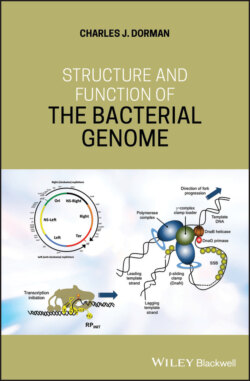Читать книгу Structure and Function of the Bacterial Genome - Charles J. Dorman - Страница 50
1.39 FIS and the Stringent Response
ОглавлениеStable RNA (tRNA and rRNA) genes that are stimulated by FIS are subject to control by the stringent response (Condon et al. 1995b; Potrykus and Cashel 2008). Here, an intracellular signal known as an ‘alarmone’ interferes with the ability of RNA polymerase to transcribe a subset of genes, including the stable RNA genes. The alarmone is guanosine tetraphosphate (ppGpp) or pentaphosphate (pppGpp) and it is synthesised in response to a build‐up of uncharged tRNA molecules and the interaction of the RelA protein with stalled ribosomes (Brown et al. 2016; Hauryliuk et al. 2015; Richter 1976) (see Section 6.18 for a more complete description of the stringent response). This accumulation results from a shortage of amino acids to charge the tRNAs and is an indication that the translational capacity of the cell exceeds demand. Hence the feedback loop that shuts down the transcription of genes involved in the production of ribosomes and other parts of the translational apparatus. The stringent response also affects DNA synthesis and mRNA translation both negatively and directly, while stimulating the transcription of genes outside the stringently regulated group (Ferullo and Lovett 2008; Haugen et al. 2006; Paul et al. 2005). What distinguishes the members of the two groups? One important factor is the possession by stringently regulated promoters of a discriminator sequence consisting of a G+C‐rich DNA between its −10 and +1 elements (Figure 1.19) (Lamond and Travers 1985; Mizushima‐Sugano and Kaziro 1985; Travers 1980; Travers et al. 1986; Zacharias et al. 1989). The discriminator is an effective barrier to open complex formation, possibly due to the extra hydrogen bonding between DNA strands consisting of G+C‐rich sequences. Negative supercoiling of the DNA has a stimulatory effect on the promoters of stable RNA genes and this may assist with the melting of the recalcitrant discriminators when negative supercoiling is available (Schneider et al. 2000). However, in bacteria experiencing low metabolic flux (e.g. those in lag phase or stationary phase) this stimulatory influence is absent and the resulting relaxation of the DNA template, combined with the negative influences of the (p)ppGpp alarmone and the DksA protein, cooperate to repress transcription of stable RNA genes (Potrykus and Cashel 2008; Schneider et al. 2000). Genes subject to stimulation by (p)ppGpp and DksA also possess a discriminator, but in these cases this element is an A+T‐rich DNA sequence (Figure 1.19) (Gummesson et al. 2013).
Figure 1.19 The multifaceted stringent response. A summary is shown of the processes that are inhibited or enabled by the alarmone (p)ppGpp. (a) (p)ppGpp and DksA affect a stringently regulated promoter that contains a G+C‐rich discriminator sequence negatively. Genes encoding rRNA or tRNA are in this category. (b) In contrast, (p)ppGpp and DksA affect a promoter with an A+T‐rich discriminator positively. Genes involved in amino acids biosynthesis are in this category. (c) The (p)ppGpp alarmone biases the selection of sigma factors by RNA polymerase away the RpoD housekeeping sigma factor and towards sigma factors that are required for various stress responses. (d) The initiation of chromosome replication is inhibited by (p)ppGpp. (e) Translation initiation and translation elongation are affected negatively because (p)ppGpp has an inhibitory influence on Initiation Factor 2 (IF2) and on the translation elongation factor, EF, respectively.
